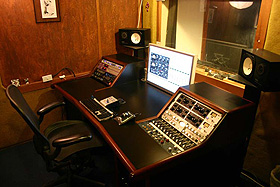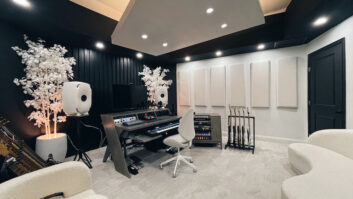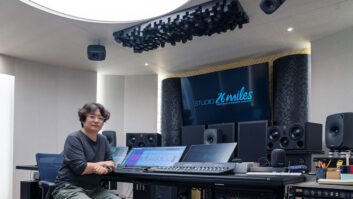
Winslow Ct. Recording Studio
Singer/songwriter Rich Sheldon
Each month, we talk to professionals who give us an insider’s look at studio life. This month, we decided to turn the tables a bit and talk to the artists who keep studio owners in business. We wanted to find out what makes them tick, how they go about choosing a studio, what qualities they really look for,and what impresses them enough to open their wallets to record there. What we found out was that artists are looking for a lot more than just gear and cred. They want comfort. They want charm. They want skill. And, in many cases, they want an experience that is ultimately going to produce life-changing results.
FAMILIARITY DRAWS THEM IN
We really don’t have to drive home the idea of competition, do we? There are exceptions, of course, but most of us are painfully aware that potential clients have more than a few choices to meet their recording needs, so we were curious about what allures an artist to a studio in the first place. Is it all about money? Do fancy digs do the trick? What is it that makes an artist choose one studio over another? First and foremost, artists are more inclined to try out a studio because people they know have had a good experience. It’s that all important word-of-mouth phenomenon.
That’s what drew Venice Beach, Calif., singer/songwriter Rich Sheldon to Hollywood’s Winslow Ct. Recording Studio. Some music buddies of Sheldon’s told him about it, and despite some previously disappointing recording experiences, he decided to give the studio a whirl. Baltimore-based singer/songwriter Bob Sima didn’t have a middleman; he met Bloomington, Ind.’s Airtime Studio owner David Weber at a gig and hit it off. “I opened for this amazing singer, Krista Detor, and her husband, [Weber], one night, and after the gig was over, we were sitting around having a glass of wine, and David said, ‘You have to come out to my studio in Indiana.'”
Sima admits that he forgot about the invitation for a while, but after a failed attempt to record in a local studio, Sima popped a CD Weber had given him into his car stereo, and he was hooked. “The moment I heard the first song on the CD, I got goosebumps,” says Sima. But what sealed the deal was the reaction from a very important person in Sima’s life. “My 2-year-old son was sitting in the backseat, and he kept saying, ‘Play it again, daddy.’ We must have listened to one song 11 times, and that was that; I made the phone call to David to get out to Indiana.”
In fact, clients will travel from far-away places—across the world, in fact—to get to a studio they feel some sense of familiarity with. Take Nashville’s Omni Sound Studios. With all of the obvious competition, we were surprised to learn that Omni entertains clients from as far away as Australia. And it hasn’t been the result of word of mouth; in many cases, it’s thanks to the Internet. “We rely on the Internet a great deal to get new clients, and one of the most effective tools we’ve used is a video on our homepage in which I introduce myself,” says studio owner Steve Tviet. “Even if people are coming from another country, they feel like they know me because they’ve seen me and a little bit of my personality, and the personality of the studio from the video. It’s a big deal for artists to go a long way from home to do a recording project, so establishing a sense of familiarity and comfort before they ever set foot in the studio is really important.”
Another way Tveit helps establish that familiarity is by making himself accessible to clients and potential clients—just about anytime they call. “When someone calls or e-mails, I either answer the phone or immediately get back to them,” says Tveit, who admits that the one drawback to this is that it does tend to drive his wife crazy. “I’ve just found that giving immediate attention is really key. In the past, I’ve had interns take a message for me when a potential client calls in, and I’d call them back the next day, but by then, they’d already found another studio to work with. A lot of things happen last minute and artists want answers immediately, so I try to meet that need and give them personal attention at just about all times of the day or night.”
Scottish songwriter Ed Gardyne
PERSONALITY HOOKS THEM
Making yourself accessible is one important piece of the puzzle, but it’s irrelevant if what’s on the other side of the phone isn’t personable, friendly and interesting. Artists tend to be colorful creatures by nature, so in many cases they find themselves most comfortable in studios and with people who have a story to tell. That was how it happened for Sima. He got on an airplane and headed off to a town he knew nothing about in the middle of nowhere and found himself in a cozy farmhouse sipping wine and watching his new producer build arrangements on the fly at his kitchen table as Sima kicked out his tunes. “I really had no idea what to expect, but I felt like I walked into heaven on earth,” says Sima. “Here I was with a guy who was once a trapeze artist in the circus, who had built his house and studio board by board, and who could listen to a minute or so of each of the songs I brought as I played them on the guitar, chart them out and make note of all the players he was going to bring in for each. I was sucked into this other world. I remember sitting there in the back of the studio and watching as the door opened and this understated guy wearing tennis shorts walked over to the B3 and started playing. He went on to lay down all kinds of piano, harmonica and accordion on my tracks. It was unbelievable.”
According to Sheldon, the most colorful character at Winslow Ct is owner Craig Parker Adams. “He’s hilariously funny, and right off the bat we totally clicked,” says Sheldon. “He makes me laugh the entire time we’re working while keeping it all professional. He is really able to make it fun at the same time.” Adams’ studio, itself, is intriguing. It’s located in an old RCA sound stage where they would record Foley. “When you first walk in to the studio, there’s a huge picture of Frank Zappa standing next to this enormous sound board,” explains Sheldon, who says one of the studio’ s staff is good friends with Dweezel Zappa. “It’s warm and inviting, and just a really great place.”
It was the trust factor that sealed the deal for Scottish songwriter Ed Gardyne, aka “Kodyne.” An experienced businessman, Gardyne’s biggest concern was working in a studio that would have his best interest at heart. “I did my research on the Internet and talked on the phone with the guy several times before making a decision,” says Gardyne. “I tend to go off of gut feelings and intuition, and I got a good feel for Andy and his studio, and I have been working with him ever since.”
Airtime Studio
DON’T FORGET MAD SKILLS
While a studio owner’s personality plays an important part in helping to draw in would-be clients, there’s nothing that can make up for good old-fashioned skill. We’re not just talking about the ability to push buttons; we’re talking about everything from knowing when to take a backseat and let an artist do his/her thing, to having an incredible gift for hearing things that may go unnoticed to others, to putting just the right touches on a project to help it shine.
Singer/songwriter Bob Sima
“I had worked with another producer before Adams, and he pushed me to play things a certain way, and he wanted to arrange the songs the way he saw fit, and I didn’t want that,” Sheldon says. “Craig allows me to be me and do it my way, which makes it a much more enjoyable experience because it allows me to express myself the way I want to.”
Artists also want to be able to rely on their producer to hear what they never could have on their own. Sima, for instance, was shocked at just how much Weber was able to hear without him even realizing it. “At the end of the week, I said to David, ‘We’ve got a pretty good-sounding scratch track, but when am I going to go in and do vocals?’ I was shocked when he turned to me, and said, ‘Vocals are done. There are only about 10 things we need to change.’” Sima then took a CD of the mixes, listened to it in the car and was astounded at what he heard. “I couldn’t believe he was able to capture my voice in such a great way without me even knowing it.”
Another key ingredient is pure and simple talent. They want to work with people who bring just as much, if not more, to a recording session as they do. Artists who record at Omni Studios have accessibility to a large variety of instrumentalists and vocalists who can create music on the fly and cut songs quickly and effectively. Says Tveit, “We can handle a 10- to 12-song project in about eight days without compromising on quality simply because we have guys who know what they’re doing.”
THE EXPERIENCE STICKS WITH THEM
While Gardyne has only recently begun his recording experience, after just three songs he’s already achieved some success. Not only have his songs received press coverage and radio airtime, but he’s been interviewed on local television. He gives part of the credit to Haldane. But perhaps most important is the fact that the experience has boosted Gardyne’s self belief. “If I had had a negative response, I would have been less likely to move forward. The fact that Haldane and I have been able to create songs that are getting some attention just makes me want to continue to go back and do more.”
It was reassurances that Sheldon received from Adams that sweetened his experience even more. “I knew that Craig wanted to see me succeed, and he always made me feel like an artist who had something important to offer,” explains Sheldon. “That was huge for me and really changed the way I look at myself and my music.” That validation wasn’t lost on Sima: “It was an amazing experience to watch the songs I wrote go from my creation to real gems. At the end of the week, we had the first mix and I drove out of there—totally in tears—because what we had created left me speechless.”
And that’s really the whole point, isn’t it? A studio’s purpose, in many ways, is to make an artist’s dreams come true—at least to some extent. “After about 30 seconds in the studio, clients get it,” says Tveit. “When they hear all the guys making their songs come to life, you can see them transform. It’s an experience of a lifetime for them.”
That’s precisely what it’s been for Sima. “Before my time with David, I had no career whatsoever. The record completely put me on the map,” the artist says. “To be able to come to a place where my songs could be recorded and take on a whole new life has honestly been the biggest change agent in my career.”
Studio Unknown is full-service audio post production facility and recording studio that specializes in helping clients discover creative sound for film, video, web, gaming, and artist projects. For more information, visit www.studiounknown.com.







